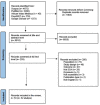Factors affecting fruit and vegetable consumption and purchase behavior of adults in sub-Saharan Africa: A rapid review
- PMID: 37113298
- PMCID: PMC10126510
- DOI: 10.3389/fnut.2023.1113013
Factors affecting fruit and vegetable consumption and purchase behavior of adults in sub-Saharan Africa: A rapid review
Abstract
In order to achieve the Sustainable Development Goals, considerable dietary shifts, including an increase in the consumption of fruit and vegetables (FV) will be required. However, worldwide consumption of FV is far below international recommendations, including in many low- and middle-income countries (LMICs), particularly in Africa. Understanding what, where, when, and how people choose to eat requires an understanding of how individuals are influenced by factors in their social, physical, and macro-level environments. In order to develop effective interventions to increase fruit and vegetable consumption, the factors influencing consumer behavior need to be better understood. We conducted a rapid review to assess and synthesize data on individual, social, physical, and macro-level factors that enable or constrain fruit and vegetable consumption and purchase among adults living in sub-Saharan Africa. Our conceptual framework is based on a socio-ecological model which has been adapted to settings in LMICs and Africa. We systematically searched four electronic databases including Scopus, Medline (PubMed), PsycInfo, and African Index Medicus, and screened Google Scholar for gray literature. We included a total of 52 studies and narratively summarized the existing evidence for each identified factor across the different levels. We found that most studies assessed demographic factors at the individual level including household or family income, socio-economic status and education. Furthermore we identified a variety of important factors that influence FV consumption, in the social, physical, and macro environment. These include women's empowerment and gender inequalities, the influence of neighborhood and retail food environment such as distance to market and price of FV as well as the importance of natural landscapes including forest areas for FV consumption. This review identified the need to develop and improve indicators both for exposure and outcome variables but also to diversify research approaches.
Keywords: consumer behavior; diets; food environment; fruit; sub-Saharan Africa; sustainable food systems; vegetables.
Copyright © 2023 Stadlmayr, Trübswasser, McMullin, Karanja, Wurzinger, Hundscheid, Riefler, Lemke, Brouwer and Sommer.
Conflict of interest statement
The authors declare that the research was conducted in the absence of any commercial or financial relationships that could be construed as a potential conflict of interest.
Figures



References
-
- Development Initiatives. 2021 Global Nutrition Report: The State of Global Nutrition. Bristol: Development Initiatives; (2021)
Publication types
LinkOut - more resources
Full Text Sources

